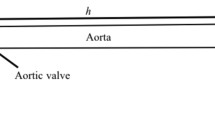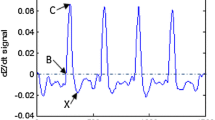Abstract
In this article, a new approach has been proposed to investigate the extraction of useful information from diastolic heart sounds caused by partially occluded coronary arteries. This method, which estimates and tracks the zeros (poles) of the diastolic heart sounds directly, takes advantage of the FTF/FAEST (Fast Transversal Filters/Fasta Posteriori Error Sequential) technique which possesses the fast convergence property of the Recursive Least Square (RLS) method and the computational simplicity of the Least Mean Square (LMS) method.
In previous studies, the main assumption was that the diastolic heart sounds were a stationary process. Since the production of the heart sounds is not a stationary process, a new approach that performs well not only for stationary but also for nonstationary processes can be required. This requirement can be satisfied by the adaptive FTF/FAEST zero tracking method which provides fast and stable convergence as well as computational efficiency since the adaptive FTF/FAEST zero tracking method is based on the exact minimization of least squares criteria and the filter weights of this method are optimal at each time instant.
The zero trajectories of the diastolic heart sounds were used to diagnose patients as diseased or normal. Results showed that the normal and abnormal records were incorrectly distinguished in only 6 of 35 cases using ablind protocol where analysis was done without knowledge of the actual disease states of the patients. The most discriminant time region of the zero trajectories of the diastolic heart sounds associated with coronary artery disease was between 200 and 300 msec after the second heart sound during the diastolic period.
Similar content being viewed by others
References
Aafif, F. Extraction and linear prediction modeling of the VEP. Piscataway, NJ: Rutgers University; 1989. Ph.D. Thesis.
Akay, M.; Semmlow, J.L.; Welkowitz, W.; Bauer, M.; Kostis, J.. Detection of coronary occlusions using AR modeling of diastolic heart sounds. IEEE Trans. Biomed. Eng. 37:366–373; 1990.
Akay, M.; Semmlow, J.L.; Welkowitz, W.; Bauer, M.; Kostis, J. Noninvasive detection of coronary occlusions using eigenvector methods before and after angioplasty. IEEE Trans. Biomed. Eng. 37:1095–1104; 1990.
Akay, M. Noninvasive detection of coronary artery disease using advanced signal processing methods. Piscataway, NJ: Rutgers University; 1990. Ph.D. Dissertation.
Akay, M.; Welkowitz, W.; Semmlow, J.L.; Kostis, J. Application of the ARMA method to acoustic detection of coronary artery disease. Med. Biol. Eng. Comput. 29:365–372; 1991.
Akay, M.; Welkowitz, W.; Semmlow, J.L.; Kostis, J. Noninvasive detection of coronary artery disease using adaptive line enhancer method. Med. Biol. Eng. Comput. 30: 147–154; 1992.
Akay, M.Y.; Akay, M.; Welkowitz, W.; Semmlow, J.L.; Lefkowicz, S. Spectral analysis of the turbulent sounds created by occluded femoral arteries in dogs. RI: IEEE 18th Annual Northeast Bioengineering Conference; 1992.
Akay, M.Y.; Akay, M.; Welkowitz, W.; Semmlow, J.L.; Lefkowicz, S. Analysis of the turbulent sounds created by occluded femoral arteries in dogs. (submitted for publication).
Akay, M.; Akay, Y.M.; Welkowitz, W.; Semmlow, J.L.; Kostis, J., Application of adaptive FTF/FAEST zero tracking filters to noninvasive characterization of the sound pattern caused by coronary artery stenosis before and after angioplasty. Ann. Biomed. Eng. 21:9–17; 1993.
Bruzzone, S.P.; Kaveh, M. Information tradeoffs in using the sample autocorrelation function in ARMA parameter estimation. IEEE Trans. Acoustics Speech, Signal Processing 32:701–715; 1984.
Box, G.; Pierce, D. Distribution of residual correlations in autoregressive-integrated moving average time series models. J. Am. Statist Assoc. 64:122–145; 1970.
Carayannis, G.C.; Manolakis, D.; Kalouptsidis, N. A fast sequential algorithm for least-squares filtering and prediction. IEEE Trans. Acoustics, Speech, Signal Processing 31: 1394, 1983.
Chen, J.; Vandewalle, J.; Sansen, W.; Vantrappen, G.; Janssens, J. Adaptive method for cancellation of respiratory artifact in electrogastric measurements. Med. Biol. Eng. Comput. 27:57–63; 1989.
Cheng, T.O. Diagnostic murmur caused by coronary artery stenosis. Ann. Intern. Med. 72:543–546; 1970.
Cioffi, J.; Kailath, T. Fast recursive least squares, transversal filters for adaptive filtering. IEEE Trans. ASSP 34: 304; 1984.
Dock, W.; Zoneraich, S. A diastolic murmur arising in a stenosed coronary artery. Am. Journal of Medicine 42:617; 1967.
Duncan, G.W.; Gruber, T.O.; Dewey, C.F.; Myers, G.S.; Lees, R.S. Evaluation, of carotid stenosis by phonoangiography. New England J. Med. 27:1124–1128; 1975.
Ferrara, E.R.; Widrow, B. Multichannel adapttive filtering for signal enhancement. IEEE Trans. AS-28:606–610; 1981.
Friedlander, B.; Porat, B. Modified Yule-Walker of ARMA spectral estimator. IEEE Trans. Aerospace, Electron. Syst. 20:158–172; 1984.
Ganong, W.F. Review of medical physiology. Los Altos, CA: Lange Medical Publications 1981.
Giddens, D.P. Measurements of disordered flows distal to subtotal vascular stenoses in the thoracic aortas of dogs. Circulation Research 39(1):112–119; 1976.
Guyton, A.C. Textbook of medical physiology. Philadelphia, PA: W.B. Saunders; 1987.
Haykin, S. Adaptive filter theory. Englewood Cliffs, NJ: Prentice, Hall; 1986.
Izraelevitz, D.; Lim, J.S. Spectral characteristics of the overdetermined normal equation method for spectral estimation. Proc. 2nd ASSP Spectral Estimator Workshop; 1983: pp. 49–54.
Kartchner, M.M.; McRae, L.P.; Morrison, F.D. Noninvasive detection and evaluation of carotid occlusive disease. Arch. Surg. 106:528–535; 1973.
Kaveh, M. High resolution estimator for noisy signals. IEEE Trans. Acoustic, Speech, Signal Processing 27:286–297; 1979.
Kaveh, M.; Bruzzone, S.P. A comparative overview of ARMA spectral estimators. Proc. 1st ASSP Spectral Estimation Workshop; pp. 2.4.1–2.4.8.
Kay, S.M.; Marple, S.L. Spectral analysis: A modern perspective. Proc. IEEE; 1981: pp 69: 1380–1419.
Kendall, M.; Stuart, A. The advanced theory of statistics. 4th ed. London: Griffin and Co; 1977.
Kentie, M.A.; Van Der Schee, E.T.; Grashius, J.L.; Smout, A.J.P.M. Adaptive filtering of canine electrogastrographic signals. Part 1. System design. Med. Biol. Eng. Comput. 19:759–764; 1981.
Khalifa, A.M.A.; Giddens, D.P. Characterization of poststenotic flow disturbances. J. Biomechanics 14:275–296; 1981.
Ko, C.C.; Thum, K.L.; Ser, W.; Quek, T.S. A simple fast adaptive zero tracking algorithm. Signal Processing 20:315–323; 1990.
Krupp, M.A. Current medical diagnosis and treatment. Los Altos, CA: Lange Medical Publications; 1982.
Kurtz, K.J. Dynamic vascular auscultation. Am. J. Med. 76:1066–1074; 1984.
Lees, R.S.; Forbes Dewey, Jr., C. Phonoangiography: A new noninvasive diagnostic method for studying arterial disease. Proc. Natl. Acad. Sci. 67:935–942; 1970.
Lees, R.S.; Myers, G.S. Noninvasive diagnosis of arterial disease. Adv. Intern. 23:475–509; 1982.
Makhoul, J. Spectral linear properties and applications. Trans. ASSP 29:282–296; 1981.
Markel, J.D.; Gray, A.H. Linear prediction of speech. 3rd ed. New York: Springer-Verlag; 1982.
Nehorai, A.; Starer, D. Adaptive pole estimation. IEEE ASSP Vol. 38; 1990.
Orfanidis, S.J. Optimum signal processing. New York: Macmillan; 1988.
Orfanidis, S.J.; Vail, L.M. Zero tracking adaptive filters. IEEE Trans. ASSP 34:1566–1572; 1986.
Padmanabhan, V., Fisher, R.; Semmlow, J.L.; Welkowitz, W.; Kostis, J. High sensitivity PCG transducer for extended frequency applications. Proc. IEEE Frontiers Medicine; Seattle. 1989: pp. 57–59.
Ragowski, Z.; Gath, I.; Bental, E. On the prediction of epileptic seizures. Biol. Cybernet. 42:9–15; 1981.
Sangster, J.F.; Oakley, C.M. Diastolic murmur of coronary artery stenosis. Br. Heart J. 35:840–844; 1973.
Semmlow, J.L.; Welkowitz, W.; Kostis, J.; Mackenzie, W. Coronary artery disease-correlates between diastolic auditory characteristic and coronary artery stenoses. IEEE Trans. Biomed. Eng. 30:136–139; 1983.
Semmlow, J.L.; Akay, M.; Welkowitz, W. Noninvasive detection of CAD using parametric analysis methods. IEEE EMBS Magazine 9:33–37; 1990.
Shan, T.J.; Kailath, T. Directional signal separation by adaptive arrays with a root tracking algorithm. Proc. IEEE Int. Conf. ASSP; TX. 1987: pp. 2288–2291.
Slock, D.T.M.; Kailath, T. Fast transversal with data sequence weighting. IEEE Trans. ASSP Vol. 37; 1989.
Teichholtz, L.E.; Steinmetz, M.Y.; Escher, D.; Herman, M.V.; Mahoney, D.V.; Ellestad, M.H.; Naimi, S. Cardiointegram: Detection of CAD using in patients with normal resting electrocardiograms. J. Am. Coll. Cardio., 3:598; 1984.
Vail, L.M. Linearly constrained zero-adaptive algorithms and adaptive array superposition. Piscataway, NJ: Rutgers University; 1985. M.S. Thesis.
Von Mises, R. Mathematical theory of probability and statistics. New York: Academic Press; 1964.
Wang, J.Z.; Tie, B.; Welkowitz, W.; Semmlow, J.L.; Kostis, J. Modeling sound generation in stenosed coronary arteries. IEEE Trans. on BME 37:1087–1094; 1990.
Welkowitz, W.; Akay, M.; Wang, J.Z.; Semmlow, J.; Kostis, J. A model for disturbed coronary artery flow with phonocardiographic verification. In: Sideman, S., Beyer, R., eds. Activation, circulation and transport in the cardiac muscle, Norwell, MA: Kluwer Academic Publishers; 1990.
Author information
Authors and Affiliations
Rights and permissions
About this article
Cite this article
Akay, M., Akay, Y.M., Welkowitz, W. et al. Noninvasive characterization of the sound pattern caused by coronary artery stenosis using FTF/FAEST zero tracking filters: Normal/abnormal study. Ann Biomed Eng 21, 175–182 (1993). https://doi.org/10.1007/BF02367612
Received:
Revised:
Issue Date:
DOI: https://doi.org/10.1007/BF02367612




